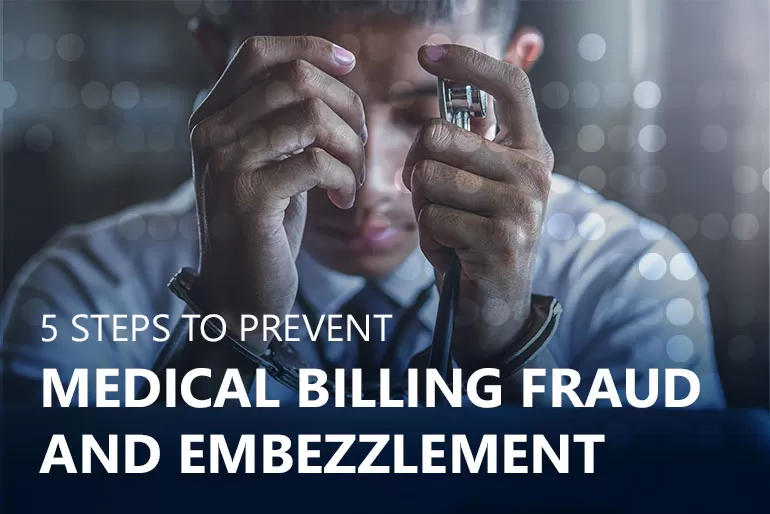If you think that your organization is immune to threats like fraud and embezzlement, you need to catch up with the 21st century.

Your practice isn’t as safe as you think, and there are numbers to prove it. According to the Medical Group Management Association, 83% of medical practices surveyed reported instances of embezzlement and financial loss from employee dishonesty over the lifetime of their practice. Not enough evidence for you? The Association of Certified Fraud Examiners (ACFE) 2018 report cited the healthcare industry as the fourth highest in billing fraud from incidents including stealing, skimming, and tampering with payments.
Why are Medical Practices Susceptible to Employee Fraud?
The unfortunate truth is that physicians’ first priority is patient care, as it should be. Often times, such a focus on practicing medicine and providing quality patient care leads to inefficiency and oversight in front-office business operations. Especially for smaller, niche practices – when you entrust day-to-day business and financial operations to one or only a few individuals, it leaves your practice incredibly vulnerable. Bottom line – there should be just as much focus on financials as there is dedicated to patients.
How to Prevent Healthcare Fraud
Although no practice is 100% safe, there are a few simple protocols that can be made to ensure heightened awareness and prevent financial loss.
- Segregate duties within the finance function – Make sure that the individual responsible for collecting payments is separate from the individual that deposits them. This is obviously easier said than done for smaller practices. In this case, it’s essential that the head of the practice be involved in daily operations as often as possible.
- Keep all patient financial information digitally stored and encrypted – Never keep patient information (like credit card numbers) written down. IT security and cash controls are crucial.
- Tie all deposits to your practice software management’s daily report – When there's a central database for all deposit information, it provides for easier tracking and simpler day and month-end reconciliations. Include encounters, charges, collections, write-offs, etc.
- Implement regular or surprise audits and reviews - This not only monitors employee conduct and behavior, it also helps to ensure that receipts are only being generated from the billing system. To that end, ImagineBillingTM administrative capability allows users to audit which screens have been accessed by which users, as well as what changes have been applied to the system, where the change was performed, and more.
- Make timely bank reconciliations – It’s crucial for practices to internally monitor cash reconciliation and accounts receivable on a weekly, or daily basis to keep track of what comes in from patients and third-party payers and what they haven’t paid. Cash balances from the bank must match what's on the organization's financial records in order for physicians to get the most out of their practice. BankingQTM payment reconciliation will not only improve accuracy in financial reporting, but has the potential to uncover fraud as well. It's imperative that each day's bank deposit slip and credit card activity be entered into your accounting software (i.e. QuickBooks or Quicken), using the same date as the deposit slip. Following this process ensures that all collections for both systems agree.
With so many practices lacking sufficient internal controls over cash, a heightened concern for medical practice employee fraud continues to grow. Knowing how to prevent medical fraud is the best offense. Finding the balance between patient and financial care with the proper protocols set in place will not only enable your billing process to run smoothly, but prevent costly fraud as well.